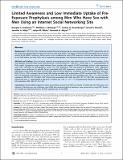| dc.contributor.author | Krakower, Douglas S. | |
| dc.contributor.author | Mimiaga, Matthew James | |
| dc.contributor.author | Rosenberger, Joshua G. | |
| dc.contributor.author | Novak, David S. | |
| dc.contributor.author | Mitty, Jennifer A. | |
| dc.contributor.author | White, Jaclyn M. | |
| dc.contributor.author | Mayer, Kenneth Hugh | |
| dc.date.accessioned | 2012-10-22T17:25:11Z | |
| dc.date.issued | 2012 | |
| dc.identifier.citation | Krakower, Douglas S., Matthew J. Mimiaga, Joshua G. Rosenberger, David S. Novak, Jennifer A. Mitty, Jaclyn M. White, and Kenneth H. Mayer. 2012. Limited awareness and low immediate uptake of pre-exposure prophylaxis among men who have sex with men using an internet social networking site. PLoS ONE 7(3): e33119. | en_US |
| dc.identifier.issn | 1932-6203 | en_US |
| dc.identifier.uri | http://nrs.harvard.edu/urn-3:HUL.InstRepos:9793863 | |
| dc.description.abstract | Background: In 2010, the iPrEx trial demonstrated that oral antiretroviral pre-exposure prophylaxis (PrEP) reduced the risk of HIV acquisition among high-risk men who have sex with men (MSM). The impact of iPrEx on PrEP knowledge and actual use among at-risk MSM is unknown. Online surveys were conducted to assess PrEP awareness, interest and experience among at-risk MSM before and after iPrEx, and to determine demographic and behavioral factors associated with these measures. Methods and Findings: Cross-sectional, national, internet-based surveys were administered to U.S. based members of the most popular American MSM social networking site 2 months before (n = 398) and 1 month after (n = 4 558) publication of iPrEx results. Comparisons were made between these samples with regards to PrEP knowledge, interest, and experience. Data were collected on demographics, sexual risk, and experience with post-exposure prophylaxis (PEP). Regression analyses were performed to identify factors associated with PrEP awareness, interest, and experience post-iPrEx. Most participants were white, educated, and indicated high-risk sexual behaviors. Awareness of PrEP was limited pre- and post-iPrEx (13% vs. 19%), whereas interest levels after being provided with a description of PrEP remained high (76% vs. 79%). PrEP use remained uncommon (0.7% vs. 0.9%). PrEP use was associated with PEP awareness (OR 7.46; CI 1.52–36.6) and PEP experience (OR 34.2; CI 13.3–88.4). PrEP interest was associated with older age (OR 1.01; CI 1.00–1.02), unprotected anal intercourse with ≥1 male partner in the prior 3 months (OR 1.40; CI 1.10–1.77), and perceiving oneself at increased risk for HIV acquisition (OR 1.20; CI 1.13–1.27). Conclusions: Among MSM engaged in online networking, awareness of PrEP was limited 1 month after the iPrEx data were released. Utilization was low, although some MSM who reported high-risk behaviors were interested in using PrEP. Studies are needed to understand barriers to PrEP utilization by at-risk MSM. | en_US |
| dc.language.iso | en_US | en_US |
| dc.publisher | Public Library of Science | en_US |
| dc.relation.isversionof | doi:10.1371/journal.pone.0033119 | en_US |
| dc.relation.hasversion | http://www.ncbi.nlm.nih.gov/pmc/articles/PMC3314648/pdf/ | en_US |
| dash.license | LAA | |
| dc.subject | HIV | en_US |
| dc.subject | medicine | en_US |
| dc.subject | clinical research design | en_US |
| dc.subject | infectious diseases | en_US |
| dc.subject | sexually transmitted diseases | en_US |
| dc.subject | viral diseases | en_US |
| dc.subject | oncology | en_US |
| dc.subject | cancer risk factors | en_US |
| dc.subject | public health | en_US |
| dc.title | Limited Awareness and Low Immediate Uptake of Pre-Exposure Prophylaxis among Men Who Have Sex with Men Using an Internet Social Networking Site | en_US |
| dc.type | Journal Article | en_US |
| dc.description.version | Version of Record | en_US |
| dc.relation.journal | PLoS ONE | en_US |
| dash.depositing.author | Krakower, Douglas S. | |
| dc.date.available | 2012-10-22T17:25:11Z | |
| dc.identifier.doi | 10.1371/journal.pone.0033119 | * |
| dash.contributor.affiliated | Mimiaga, Matthew J. | |
| dash.contributor.affiliated | Krakower, Douglas | |
| dash.contributor.affiliated | Mayer, Kenneth | |
| dc.identifier.orcid | 0000-0001-7460-733X | |


